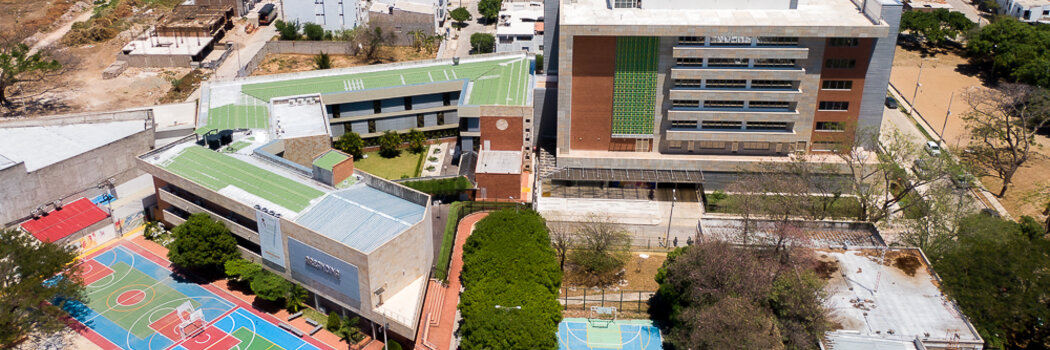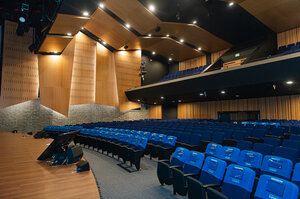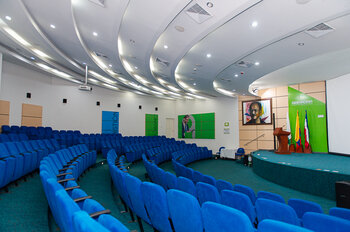
Students at University Foundation Areandina in Valledupar benefit from state-of-the art network technology

High values in education
FUNDACIÓN UNIVERSITARIA DEL ÁREA ANDINA (AREANDINA) is a non-profit private Colombian higher education institution offering more than 80 academic undergraduate and postgraduate programs. At three strategic sites in Bogotá, Pereira and Valledupar more than 30,000 students are gaining high-quality education. In 2018 the institution decided to heavily invest in growing and modernizing the Valledupar campus by adding a new, state-of-the-art building with modern IT infrastructure and a high-speed network. While the first concept was made based on a traditional network infrastructure, the university finally voted for the future-proof, sustainable and flexible FTTO-concept.
Significant advantages of FTTO
The requirements of the Areandina project team were clear: They were looking for a cost-effective high-end network concept suitable to integrate all kinds of applications. ProE consulting as a value- added distributor of MICROSENS technology was convinced that the FTTO technology would be perfectly suited to meet the universities needs. In contrast to traditional network topologies the FTTO concept is based on connecting the optical fiber from the central switching unit directly to a managed Micro Switch in the office or in case of the university in the lecture hall. There is no need for an additional network room on each floor resulting in multiple advantages: Investment costs (CapEx) are lower due to the significantly reduced cabling and installation efforts. Operating costs are also on a much lower level as there are no costs for cooling and maintaining the sub distribution. At the same time, the available space is used much more efficiently.
As the MICROSENS Micro Switches are available with Power over Ethernet (PoE) functionality, devices such as WiFi access points or IP phones do not need separate power supplies. To learn about the technology in practical use, José Guevara, IT director at Areandina, visited the Instituto Tecnológico Metropolitano (ITM) in Medellin where FTTO was already up and running. He states: “Saving around 40% of the costs compared to a structured cabling while offering high speed and utmost flexibility - the technology sounded just amazing. It was great to see that our colleagues at the ITM absolutely confirmed the benefits from their practical experience.”

Smart options for building automation
In parallel to looking for network solutions, Areandina started to evaluate access control systems as well as additional building automation solutions that could be integrated at a later stage. José Guevara explains: “We thought of separate solutions, but FTTO offers us enormous flexibility as the generation 6 devices enables us to directly integrate building automation systems in our network.” Air conditioning, lighting, access control, shading – everything can be controlled via the FTTO network making it easy to efficiently use energy. The PoE functionality of the MICRO Switches further simplifies the implementation of the automated building solutions as devices with lower power consumption don’t need an additional power cabling. Given all those advantages, Areandina decided to implement an FTTO network in the flagship building at the Valledupar campus. Four 10G multi-fiber distribution switches have been implemented and connected to 237 Micro Switches with a star-shaped topology with more than 1100 data points The connections between the distribution switch and the Micro Switches use multi-mode fiber, the devices in the room can directly be connected via standard RJ45 interfaces and copper cables.
Furthermore, Areandina uses the option to cascade the network by implementing additional full copper Micro Switches in daisy chains. Especially an expansion of the network e.g. to connect additional devices such as building automation solutions can thus be easily realized.
Future-oriented network implementation
In April 2021 Areandina celebrated the official opening of the building in Valledupar - the date had to be postponed several times due to the pandemic. Design and implementation of the network within the 12,000 square feet building was directly supported by both, the local distributor and MICROSENS. Several VLANs have been established to separate the different applications and secure the network, access control systems as well as CCTV and WiFi communications have directly been integrated via the network. José Valencia Molano, national director of the foundation of Areandina, stated: “Our new building is equipped with state-of-the-art FTTO technology offering our students fiber connections, fast internet access and excellent working conditions – it is a flagship project for our region. We are happy to contribute to further elaborate the high-end education of our young generation.”
About MICROSENS
Transmitting information via fiber optic connections offers numerous benefits. MICROSENS GmbH & Co. KG recognised this very early on. As one of the pioneers, the company has developed and produced high-performance communications and transmission systems in Germany since 1993. Individually matched to the demands of diverse usage areas and embedded in comprehensive concepts for individual sectors. But, above all, close to the customer. Technical challenges from customer projects are incorporated directly into product development. This way, IP-based automation solutions are created for modern buildings, cost-efficient network concepts for the office and workspace, robust and fail-safe solutions for industrial environments, optical transport systems future-oriented wide area networks and efficient coupling of sites and computer centres.










